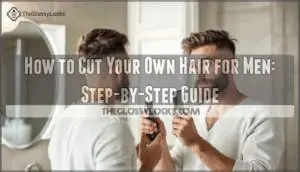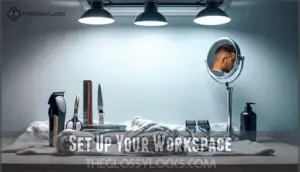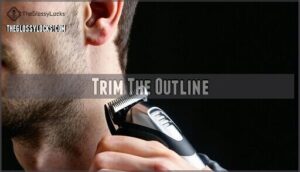This site is supported by our readers. We may earn a commission, at no cost to you, if you purchase through links.
 The average guy spends about $330 a year on haircuts. That’s money walking out the door every few weeks, and it adds up fast. Learning to cut your own hair isn’t just about saving cash—it’s about taking control of something you’ve been outsourcing your entire life.
The average guy spends about $330 a year on haircuts. That’s money walking out the door every few weeks, and it adds up fast. Learning to cut your own hair isn’t just about saving cash—it’s about taking control of something you’ve been outsourcing your entire life.
The first time you buzz your own sides and blend a fade without stepping foot in a barbershop, something clicks. You realize the skills barbers use aren’t magic tricks reserved for the professionals. They’re techniques anyone can learn with the right tools, a steady hand, and a bit of practice.
You’ll make mistakes at first, but even a mediocre self-cut beats waiting three weeks for an appointment when your hair’s growing wild. This guide breaks down each step so you can transform your bathroom into your personal barbershop.
Table Of Contents
- Key Takeaways
- What You Will Need
- Set Up Your Workspace
- Wash and Comb Your Hair
- Trim The Sides
- Trim The Back
- Fade The Sides and Back
- Trim The Outline
- Cut The Top
- Style Your Hair
- The Look: Buzzcut Season
- Frequently Asked Questions (FAQs)
- How do you cut hair if you are a beginner?
- How to cut men’s hair at home?
- Can you cut your own hair?
- How do you cut your own hair at home?
- Does a man need a haircut?
- Is it easy for a man to give himself a haircut?
- How should I decide which hairstyle will suit me?
- What techniques can I use to avoid mistakes while cutting my hair?
- Should I use scissors or clippers?
- How can I maintain my hairstyle between cuts?
- Conclusion
Key Takeaways
- Learning to cut your own hair saves around $330 annually while giving you complete control over your appearance and schedule, eliminating the need for barbershop appointments.
- The key to successful DIY haircuts lies in proper setup—using quality clippers with multiple guard sizes, positioning mirrors to see all angles, and working methodically from sides to back to top.
- Fading requires patience and technique: blend guard lengths gradually by overlapping passes and flicking outward at transition points, checking symmetry constantly to avoid harsh lines.
- Your first few self-cuts won’t be perfect, but each attempt sharpens your skills—within a few sessions, you’ll develop the speed and precision that makes home haircuts a sustainable, money-saving skill for life.
What You Will Need
Before you start cutting, you’ll want to gather the right tools to make the job easier. Having everything within reach helps you work smoothly and avoid mistakes.
Here’s what you need to get started.
Electric Trimmer
Think of an electric trimmer as your precision control tower—it’s the tool that lets you dial in exactly how much hair comes off without guesswork. Look for cordless trimmers with multiple guard sizes, usually ranging from 1/16 inch to 1 inch, so you can create clean fades and blend different lengths seamlessly.
Pay attention to motor types—rotary motors offer more power for thick hair, while magnetic motors run quieter. Blade maintenance matters too; keep those blades oiled and sharp for smooth cuts.
An ergonomic design prevents hand fatigue during longer sessions, which makes a real difference when you’re using clippers on yourself. The right clipper guard transforms a basic trim into a sharp, professional-looking cut.
Invest in quality hair clippers—they’ll give you better control and last through dozens of haircuts.
Hair Clippers
While electric trimmers manage the detail work, hair clippers are your workhorse for cutting bulk and establishing the foundation of your style. Choose clippers with strong motors—rotary types power through thick hair while magnetic motors run quieter. Cordless options give you freedom to move around without wrestling cables.
Key features to prioritize:
- Multiple clipper guard sizes (usually #1 through #8) for flexible length control
- Quality clipper brands like Wahl, Andis, or Oster that withstand regular use
- Easy blade maintenance with detachable heads for cleaning and oiling
- Ergonomic grip that prevents hand cramping when using clippers for extended sessions
Master your clipper guard settings and you’ll control every aspect of your cut.
Hand Mirror
You can’t see the back of your own head without a hand mirror—that’s where this simple tool becomes your second set of eyes. Position a handheld mirror behind you while facing your bathroom mirror to create visibility angles that reveal every detail of your DIY haircut. Choose a mirror size between 6-10 inches for the best balance of portability and viewing area.
When cutting your own hair, this back mirror setup transforms guesswork into precision. You’ll spot uneven sections, check your fade, and confirm symmetry before mistakes become permanent.
Look for these features:
- Cordless option that won’t limit your movement during the self haircut process
- Magnification levels (usually 1x or 2x) to catch fine details along the neckline
- Sturdy grip with a non-slip grip for steady back mirror checks
Hair Comb
Before clippers touch hair, a wide-toothed comb separates every strand so your scissors or trimmers can glide through without snagging or missing sections. This tool keeps hair in place while you cut, making sectioning easier and helping you maintain even length across your haircut.
Essential comb features:
- Wide teeth for detangling benefits without pulling damp hair
- Fine teeth on the opposite end for precise sectioning aid during detailed clipper work
- Anti-static material that prevents flyaways and improves styling influence after your cut
Set Up Your Workspace
Once your tools are lined up, finding the right spot to cut becomes your next move. Pick a bathroom or kitchen with good lighting—shadows can trick you into uneven cuts. Set up your handheld mirror so you can check the back and sides without guessing. Surface protection matters too, so drape an old towel over the counter or floor to catch loose hair.
Here’s a quick setup checklist for assembling haircutting tools and preparing for a home haircut:
| Setup Element | What to Do | Why It Matters |
|---|---|---|
| Lighting considerations | Use bright overhead lights | Helps spot uneven sections |
| Mirror placement | Position handheld mirror behind you | Shows hard-to-see areas |
| Tool organization | Line up clippers, guards, comb nearby | Keeps workflow smooth |
| Hair disposal | Place towel or newspaper down | Makes cleanup faster |
Keep everything within arm’s reach. When you’re mid-cut, fumbling for tools breaks your rhythm and can lead to mistakes.
Wash and Comb Your Hair
Clean hair cuts better than dirty hair, so hop in the shower and shampoo away any buildup, oil, or product residue before you pick up your clippers. Work the shampoo through your scalp, then rinse completely—conditioner helps if your hair tangles easily. Towel off until damp, not dripping. While it’s still wet, run a wide-tooth comb from roots to ends to knock out any knots. This prep work gives your clippers a clean, even surface to glide across.
Why hair washing matters for your cut:
- Clean strands show their true texture—no surprises halfway through
- Detangling now saves you from tugging and uneven sections later
- A fresh scalp lets clippers cut at consistent lengths without fighting through gunk
Trim The Sides
With your hair clean and tangle-free, it’s time to tackle the sides—the foundation of most modern men’s cuts. Start by selecting the right clipper guard for your desired side length—lower numbers mean shorter hair. Position your hair clippers at the bottom of your sideburn and move upward against hair growth in smooth, steady passes. Work methodically from front to back, overlapping each stroke slightly to avoid missed patches.
Side Lengths & Guard Selection:
| Guard Number | Length Result | Best For |
|---|---|---|
| #1–2 | Very short, tight | Bold, minimal maintenance |
| #3–4 | Medium fade base | Balanced, adaptable styles |
| #5–6 | Longer sides | Natural, textured looks |
Keep checking symmetry by comparing both sides in your mirror. Cutting your hair evenly requires patience—don’t rush through one side faster than the other. These hair cutting techniques set you up for clean blending next.
Trim The Back
The back is where most DIY haircuts go sideways—literally—because you’re working blind without proper setup. Mirror positioning is your best defense: hold a handheld mirror at arm’s length behind you while facing your bathroom mirror. This lets you see exactly what you’re cutting.
Use the same guard you chose for the sides and start at the neckline, working upward in vertical passes. Move your clippers slowly—rushing creates patches you’ll only spot later. Overlap each stroke to maintain consistent length across your back hair. The goal isn’t flawlessness on the first pass.
Check frequently by angling your mirror, adjusting your stance until you catch every section. Cutting your back hair takes patience, but proper blending techniques start here. Once you’ve covered the entire back evenly, you’re ready for the fade.
Fade The Sides and Back
Fading is where you blend different clipper lengths to create a smooth progression from short to longer hair. The goal is to make each layer flow seamlessly into the next without any harsh lines.
Here’s how to fade the sides, back, and temples for a clean, professional look.
Fade The Sides
Start with your longest guard setting—this is where you’ll build the foundation for a smooth, gradual shift from short to long. Run your clippers upward against the hair growth, then flick outward as you reach the blending point. This clipper angle creates the taper variations that define a proper fade haircut.
Switch to shorter guard lengths as you move downward, blending techniques that guarantee perfect symmetry. Check both sides constantly—achieving a fade demands balance.
Fade The Back
Fading the back requires a steady hand and a little patience—you’re working blind, so precision beats speed every time. Use your hand mirror to check mirror angles as you blend.
Start with longer guard lengths at the crown, then drop down gradually to create a tapered nape. Run your hair clippers in upward strokes, avoiding lines by overlapping passes.
Proper blending techniques keep your fade haircut looking uniform, not choppy.
Fade The Temple
Temple fading is where most DIY cuts go sideways—the angles get tricky and your hand positioning matters more than anywhere else on your head. Use your clipper guard to blend upward in short strokes, not long sweeps. Switch to a lower guard as you work down toward the sideburns. Keep your hair clippers flat against your head to avoid gouging lines.
Common mistakes to avoid:
- Pressing too hard – Let the clippers do the work or you’ll create bald patches in your temple fade styles.
- Skipping guard lengths – Dropping from a 3 to a 1 leaves harsh lines; proper blending techniques require stepping down gradually.
- Cutting against the grain first – Start with the hair’s natural direction, then perfect with opposing strokes.
- Forgetting to check both sides – Asymmetry kills maintaining fade shape; compare temples constantly using your mirror.
Trim The Outline
Once your fade looks smooth, you’ll need to clean up the hairline around your ears, sideburns, and neck to give the cut a sharp, finished edge. This is where Outline Precision and Edge Refinement come into play.
Switch to your electric trimmer without a guard. Start with trimming sideburns—decide on your preferred length and cut straight across for Sideburn Shaping. Work around each ear carefully, following the natural curve for clean Shape Definition.
For tapering neckline, use this guide:
| Area | Technique | Goal |
|---|---|---|
| Hairline | Hold trimmer blade flat | Clean edge |
| Sideburns | Cut straight across | Even length |
| Ears | Follow natural curve | Smooth outline |
| Neck | Angle blade upward | Natural taper |
| Neckline | Create rounded or squared shape | Neckline Taper |
When you taper your neckline, angle the trimmer upward to blend the hair into skin naturally. Don’t cut too high—keep it about two fingers above your natural neckline.
Cut The Top
You’ve taken care of the sides and back—now it’s time to tackle the top. This is where you’ll create shape and add your personal style.
Work through each section carefully, from front to back, to keep things balanced and even.
Cut The Front
Now that you’ve shaped the sides and back, it’s time to tackle the front—the section that frames your face and sets the tone for your entire look. Consider your face shape and hairline concerns when cutting your hair. Work with what you’ve got, not against it.
- Comb the fringe forward and hold it between your fingers at your desired length.
- Cut straight across using hair cutting scissors, then point-cut for texture.
- Blend layers by working backward from the hairline, connecting to the top sections.
- Use texturizing techniques to soften blunt lines and create movement in fringe styles.
Cut The Middle
With the front looking sharp, you’ll move to the middle section—the crown of your head where length and volume come together. This is where style adaptability meets texture creation.
Crown Blending Technique:
| Step | Action |
|---|---|
| 1 | Comb hair straight up from crown |
| 2 | Hold section between fingers at desired length |
| 3 | Cut horizontally using scissors (not clippers) |
| 4 | Point-cut edges for texture creation |
| 5 | Check length consistency by comparing sections |
Work in small sections, using previously cut hair as your guide. This ensures the middle section remains even throughout. The crown can be tender, so take your time with these hair-cutting techniques.
Cut The Back
Cutting the back takes patience since you can’t see what you’re doing without that second mirror—but with the right setup, you’ll trim it just as cleanly as the sides. Mirror positioning is critical: hold your handheld mirror behind your head while facing the wall mirror.
Work slowly with hair clippers or scissors, following your hair thickness pattern. Use blending techniques to connect the crown to lower back hair, checking for patches repeatedly.
This self haircut challenge demands focus—avoiding patches means constant verification between cuts.
Finishing Touches
After all that careful work, your haircut needs a final once-over to catch any uneven spots and clean up stray hairs. Run your comb through each section for a final check, trimming any patches you missed. Use your electric trimmer for detail work around the edges and hairline.
Once you’re finishing up your haircut, apply hair styling products like hair pomade to lock in your style. This hairstyle maintenance step—combining product application with a thorough clean up—transforms your cut from decent to professional-looking.
Style Your Hair
Your fresh cut is complete—now it’s time to bring it to life with the right styling products and techniques. Start with a small amount of product—pomade for shine, matte clay for texture, or cream for a natural finish.
Work it through damp hair, using your fingers to shape and direct the style you want. Your hair texture will determine what works best, so experiment until you find your ideal balance.
This is your moment for personal expression—make the look yours.
The Look: Buzzcut Season
The buzz cut is more than a DIY haircut—it’s a reset button. This style ranks as the third most popular men’s cut globally, and once you grab your hair clippers, you’ll understand why. Here’s what makes it work:
- Face shapes matter: The classic buzz suits oval, round, and square faces, while a fade softens angular features.
- Maintenance frequency is key: Refresh every two weeks to keep that sharp, clean look barbers recommend.
- Professional perception varies: Tech embraces it (74% approval), but finance runs cooler at 41%.
Buzzcut trends show 61% choose it for low upkeep. Cutting the hair doesn’t actually change the hair’s growth rate. Your clippers give you control—no salon appointments, just freedom and a look that’s entirely yours.
Frequently Asked Questions (FAQs)
How do you cut hair if you are a beginner?
Start small—like trimming a
How to cut men’s hair at home?
Before diving into a home haircut, gather your essentials: hair clippers with guards, styling scissors, two mirrors for checking symmetry, and a comb.
Washing hair beforehand prevents DIY haircut fails and guarantees clipper maintenance pays off with clean, even cuts.
Can you cut your own hair?
Cutting your own hair certainly comes with controllable challenges. DIY mens haircut success depends on skill level needed, hairstyle suitability, and time versus cost tradeoffs.
Benefits of home haircuts include freedom and reduced touch-up frequency for simple styles like buzzcuts.
How do you cut your own hair at home?
At-home grooming starts with the right setup. Gather your tools—hair clippers, electric trimmer, hand mirror, and comb.
Prepare your workspace, wash and detangle your hair, then tackle DIY haircutting by trimming sides, back, and top systematically for hairstyle maintenance success.
Does a man need a haircut?
Haircut frequency depends on personal preference and hairstyle trends. Most men benefit from regular trims every 3-6 weeks to maintain a professional appearance, but self-grooming and hair maintenance needs vary based on individual style and social norms in grooming tips.
Is it easy for a man to give himself a haircut?
Honestly? It’s not a walk in the park, but it’s doable. Self haircut success depends on your skill level, hairstyle complexity, and tool proficiency.
Simple men’s haircuts at home require patience and realistic expectations about potential mistakes.
How should I decide which hairstyle will suit me?
Look at your face shape and hair texture first—they’ll guide you toward haircut styles for men that naturally work with what you’ve got.
Then think lifestyle factors: if you’re low-maintenance, skip styles needing daily work. Your personal style matters too, so choose a haircut that fits your routine and reflects who you’re, not just what’s trending.
What techniques can I use to avoid mistakes while cutting my hair?
Know your desired style before picking up clippers. Start conservatively with a longer guard—you can always cut more.
Section precisely, checking both mirrors constantly for consistent length and avoiding uneven sides.
These hair cutting tips and tricks prevent mistakes, but don’t hesitate seeking professional help if needed.
Should I use scissors or clippers?
Both tools have their place. Clippers excel at managing bulk work and creating clean fades, especially on the sides and back.
Scissors give you precision for texturing the top and blending techniques where control matters most.
How can I maintain my hairstyle between cuts?
Imagine trimming your fade every Saturday morning with clippers—it’s like keeping a sharp edge on a blade. Touch-up trims every 4-6 weeks maintain shape as hair growth changes your look.
Between cuts, shampoo and condition regularly to keep hair healthy. Use a comb daily for styling, and apply pomade or wax for hold.
Proper hair care and product selection extend hairstyle longevity.
Conclusion
You’ve just learned how to cut your own hair for men—no more waiting rooms, no more weekly tabs piling up. The first few cuts won’t look perfect, but each one sharpens your skills and tightens your technique.
You’ll start noticing the angles barbers use, the pressure they apply, and how they blend guards seamlessly. Within a few sessions, you’ll move faster and cleaner than you thought possible.
Your mirror becomes your training ground, and your clippers become an extension of your hand. Master this, and you’ve unlocked a skill that saves time and money for life.
- https://www.medicalnewstoday.com/articles/326764
- https://www.linkedin.com/in/pierslemoignan/
- https://medihair.com/en/statistics-8-most-popular-male-hairstyles/
- https://www.hims.com/news/popular-mens-hairstyles-by-state
- https://www.wftv.com/news/this-is-most-popular-mens-hairstyle-every-state/MC4DFKSEYJN6LEILX62BSS5Y6U/











